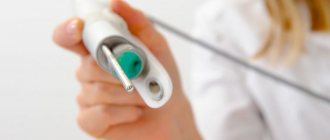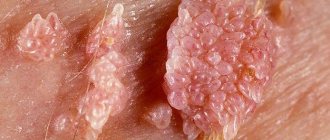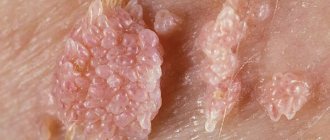Electrocoagulation of condylomas is a destructive effect on pathologically altered tissues. The influence occurs through electricity, chemicals, lasers and other methods that destroy the proteins of the cells of the growths and lead to their death. This type of treatment is widely used to remove tumors localized in various areas of the skin and mucous membranes.
What is coagulation of condylomas?
In dermatological terms, it is a series of procedures performed to remove skin lesions.
They are often used in the fight against condylomas.
There are two main types of coagulation:
- chemical;
- electric.
Chemicals are used very rarely.
Because it has limited effectiveness and often produces unwanted side effects.
The only advantage of the method is its low cost.
Anyone can buy preparations for chemical coagulation cheaply at any pharmacy.
But more often in clinics electrocoagulation is used.
It involves removing skin lesions using a special device that generates electrical impulses.
Disadvantages of the method
Among the disadvantages of laser destruction, one can note its high cost compared to other methods of removing skin tumors. In addition, after laser intervention, in some cases, undesirable consequences occur.
So, people with sensitive skin may experience burns and redness. Sometimes, as a side effect, new pigmentation appears. Swelling, redness, and increased temperature in the treated area may occur in people prone to allergic reactions (do not worry, usually after 24 hours all symptoms disappear).
In patients with unstable hormonal levels, the risk of keloid scar formation increases.
However, negative consequences after laser destruction occur extremely rarely. The main criterion for success is a qualified doctor and the availability of modern equipment.
Chemical coagulation of condylomas
The procedure involves the destruction of the formation due to the effect of chemical compounds on it.
As a rule, these are acids or alkalis.
Concentrated solutions damage the skin and cause necrosis of the part where the condyloma is located.
The technique is used only to remove small formations.
Single condylomas are removed using chemical coagulation.
The technique has a number of disadvantages:
- Multiple or large formations cannot be removed;
- Condylomas on highly sensitive areas of the skin, such as the genitals, face, neck, cannot be removed;
- high risk of burns;
- often the formation cannot be removed the first time, so coagulation has to be done again;
- Chemical burns to the skin that a person receives can be painful.
It has practically no advantages.
In fact, this is an outdated method that is not used in most clinics.
Some patients do independent chemical coagulation of condylomas.
They go to the pharmacy, buy the drug and burn it.
It is not right.
If you read the instructions, you will find that the drug is intended solely to be used by a medical professional to remove condyloma.
Because the use of such means is dangerous.
It is necessary to strictly observe the application time and avoid contact of the solution with healthy tissue.
They are lubricated with oil or petroleum jelly to protect the skin.
It is necessary to accurately calculate the amount of solution and exposure time, based on the size of the condyloma.
Coagulation must be sufficient for the formation to be destroyed.
At the same time, it should not be excessive, otherwise scars will form.
If you allow acid to come into contact with healthy skin, you will get chemical burns.
Thus, self-administered chemical coagulation of condylomas is walking on thin ice.
The probability of complete removal of the formation is far from 100%.
The risk of complications if the method is used incorrectly is much higher than the chance of getting rid of condyloma.
Causes
The main reason for the appearance of genital warts has already been mentioned: it is the HPV virus, which begins to become active when the body’s protective functions are weakened.
The following factors can provoke a decrease in immunity:
- frequent stressful situations, emotional lability;
- fatigue, lack of sleep;
- improper and irrational nutrition;
- avitaminosis;
- hypothermia;
- dysbiosis.
The main reasons for the penetration of HPV into a woman’s body are the following factors:
- Too early sexual experience.
- Use of the patient's personal belongings - towels, washcloths, underwear.
- Active sex life and frequently changing sexual partners.
- Staying in public places (bathhouse, swimming pool, sauna, shared shower, toilet).
- Not using barrier contraceptives when having sex with an infected person.
- Frequent abortions. The fact is that with frequent termination of pregnancy, abrasions and cracks form on the cervix and vagina, which become an ideal conductor for the virus.
- The likelihood of infection increases with cervical erosion.
But most often, candilomatosis is provoked by sexual intercourse with an infected person. The source of infection is the partner's genital warts. Moreover, it does not matter how the sex was carried out - the classic way, oral or anal. In the process of contact with modified cells and infected skin, the infection enters the healthy epithelium through small abrasions.
Important!
Sometimes even a condom is not able to protect against the penetration of HPV.
If you have any condylomas, even when they do not bother you, you should immediately consult a doctor: a gynecologist (women), a urologist (men) and a proctologist (both sexes), an immunologist and an ENT doctor (for papillomas in the pharynx and tonsils). New growths that appear may disappear as suddenly as they appeared, but this should not reassure you. The human papillomavirus, once it enters the body, remains in it forever. The task of doctors is not to completely eliminate the infection - this is impossible. To avoid serious consequences, such as cancer, it is enough to transfer the pathogen from the acute to the latent phase.
Removing genital warts is a serious thing; if you do something wrong, there may be consequences that you would not expect (from the opposite effect - the growth of new ones, to neoplasms on the skin). I strongly do not recommend trying to get rid of condylomas at home; it is better to turn to specialists; besides, today there are many solutions to this problem. Removing condylomas with liquid nitrogen, laser, radio waves - all these are effective methods that remove the disease, perhaps some method will suit you.
You can have genital warts removed by a qualified gynecologist in the Doctor Nearby clinic network in Moscow. Making an appointment is very simple - call 24/7 +7 (495) 127-84-73 or create an appointment on our website.
Electrocoagulation of condylomas
This method is used much more often.
It gives a predictable and guaranteed result.
The doctor actually cuts off the condyloma using electrocoagulation.
He separates it from the body.
After this, the formation can be sent for histological examination.
This is required to detect possible signs of malignant degeneration.
Chemical coagulation does not provide this opportunity.
It destroys education completely.
Biomaterial is not preserved for histological examination.
Therefore, in the case of precancerous or oncological processes, they will not be detected in time.
Using electrocoagulation, the doctor can remove condylomas:
- large;
- multiple;
- located on any part of the body.
He places a special electrode on the skin.
Electric current heats the tissue.
As a result, protein coagulation occurs.
Anyone who has ever fried meat or scrambled eggs in a frying pan has seen how this happens.
Only here everything is much faster.
The application of electric current instantly heats the tissue, destroying it.
But this impact is targeted.
Healthy tissues are practically not damaged as a result of the procedure.
Many clinics use MTUSI equipment for coagulation of condylomas.
But we use the Fotek device.
It is good because it also has a radio wave mode.
Therefore, it makes it possible to choose the most suitable technique for removing skin lesions.
A special nozzle allows you to cauterize the bottom of the condyloma.
This is necessary to destroy viruses.
As a result of this procedure, formations do not reappear in the same place.
How can the disease be transmitted?
Papillomavirus is transmitted through contact. It is possible to become infected with HPV even by shaking hands. It is worth noting that a carrier of viral particles may not have skin manifestations in the form of condylomas, not only at the present time, but also in history. Basically, HPV penetrates epithelial cells through sexual contact of any kind. There have been cases of household contamination through the use of personal hygiene items.
At risk, regardless of the contact with the patient or carrier, are persons with weakened immune systems. This condition often occurs due to chronic stress, poor nutrition, and lack of proper routine and lifestyle. In such cases, removal of condylomas will not be a panacea, since the likelihood of relapse of the disease is high. An integrated approach to treating the problem and taking preventive measures are necessary.
Children can also become infected with condylomas. This mainly occurs when passing through the birth canal, when a child swallows superficially located viral particles, or from adult patients/HPV carriers during household contacts at home.
In both adults and children, papillomaviruses can provoke the growth of condylomas and, depending on the type of HPV, even provoke malignant degeneration of cells. Therefore, along with drug treatment, it is important to carry out radical removal of these formations. It is worth remembering that traditional methods carry the threat of complications.
The difference between coagulation of condylomas and other methods
Coagulation is far from the only way to remove condylomas.
Our clinic also uses laser vaporization, cryodestruction, radio wave, and sometimes surgical removal.
All methods have certain differences.
When performing cryodestruction, the doctor applies liquid nitrogen to the condyloma.
This procedure is close in essence to chemical coagulation.
It also leads to tissue destruction.
Only their necrosis occurs not due to a chemical burn, but due to freezing.
When thawed, the tissues die.
But cryodestruction is safer.
There is no risk that the doctor will frostbite the nearby skin.
At our medical center, specialists have sufficient experience to perform high-quality removal of papilloma with liquid nitrogen.
Application time depends on the location and size of the formation.
It is sufficient to remove the formation.
But it is not excessive, and therefore does not lead to scarring in the affected area.
Cryodestruction is used only for small condylomas.
But can be used even if they are multiple, regardless of location.
This is an advantage over chemical coagulation.
However, there are also disadvantages.
Cryodestruction can be painful after manipulation due to a local inflammatory reaction.
It also does not leave any material that could be sent for histology.
Laser vaporization is a technique for evaporating tissue.
The laser heats the tissue in the same way as during electrocoagulation.
They instantly evaporate.
There is no charring, and the effect is even more precise than with electrocoagulation.
There are no burns to adjacent tissues.
Laser radiation destroys bacteria in the wound.
In addition, removal of condyloma in this way is completely non-contact.
Therefore, infection is impossible.
Laser removal has the lowest risk of infectious complications.
But there are disadvantages.
Large condylomas are not removed by laser - only small or medium ones.
Radio wave removal is the same as excision with a scalpel.
Only a radio wave is used instead.
It differs in that it makes the cut very thin and disinfects it.
After radio wave removal, the damage heals very quickly.
The resulting scars are very thin.
There are no crusts, such as after electrocoagulation.
Using radio waves, it is possible to remove even large skin lesions.
Features of intervention to remove condylomas in children
The localization of condylomas on the skin and mucous membranes in children can be different and affect atypical areas. With a typical location of the formations, the child complains of the classic manifestations of the disease: a feeling of discomfort, itching, burning, a feeling of something extra, interfering, etc. But a small child cannot correctly formulate and express his feelings, so it is important to be careful during self-examination for timely diagnosis and seeking help from a specialist.
The peculiarity of the procedure for removing condylomas in children is the need for quick and painless manipulations, if possible during a one-time visit to the doctor’s office. Removal of epithelial growths using a laser is not accompanied by bleeding and the need for long-term rehabilitation.
Advantages and disadvantages of electrocoagulation of condylomas
The electrocoagulation method has both pros and cons.
The advantages of this technique are as follows:
- it is possible to separate the tumor from the body, so it remains possible to send it for histological examination;
- the place where the condyloma was previously treated is carried out (to destroy viruses and reduce the risk of relapse);
- the procedure usually has a low cost;
- Quite large condylomas can be removed that cannot be treated with chemical coagulation, cryodestruction or laser.
At the same time, there are also disadvantages.
Electrocoagulation is an old method that is gradually being replaced by other techniques.
Its main disadvantages are as follows:
- crust formation;
- charring of tissues;
- tissue adhesion to the electrode;
- burns, although not deep, of nearby tissues;
- healing takes longer;
- removal is carried out by contact, so the risk of infectious complications is higher than with laser or radio wave removal.
Our clinic uses not only coagulation.
We have all modern methods of genital wart removal available.
There are doctors here who master all these techniques.
This variability allows us to choose the best method for removing formations in each clinical situation, taking into account them:
- quantity;
- dimensions;
- location.
In each case, the doctor tries to carry out the removal in such a way as to achieve, on the one hand, all treatment goals, and on the other, to ensure:
- good tolerance of the procedure;
- its high safety;
- no pain after removal;
- no complications;
- rapid wound healing.
If there are several condylomas, they can be removed in various ways.
How to remove plantar warts
On the sole, the wart is deep in the skin (see photo), so electrocoagulation is not suitable for plantar tumors.
An electric knife can only remove superficial and fresh warts.
If the growth is small, it is removed from the roots.
Removal of plantar warts is best done with a laser.
The operation is quick, does not cause pain, tissues are quickly restored, and there are no relapses.
Sex after coagulation of condylomas
Whether you can have sex depends on the location of the formation.
Obviously, if you have had a condyloma removed from your nose, then this procedure will not interfere with your lovemaking.
Another thing is that papillomas are often found on the reproductive organs.
Because they are caused by a virus.
This pathogen is transmitted during sexual intercourse.
A person with condylomas can be contagious.
It remains so even after the formations are removed.
Because the virus is in the skin, and the sexual partner can become infected.
But this doesn't mean you can't have sex.
At least restrictions are not imposed to prevent the partner from becoming infected.
Because if it is permanent, then it probably became infected a long time ago.
In addition, human papillomavirus infection lasts for years.
Therefore, sex would have to be prohibited for a very long time.
It is unlikely that any of the patients would agree to such restrictions.
Another thing is that having sex after removal of condyloma is often impossible.
After all, they are often located on the genitals.
After the procedure, a crust remains there.
It is gradually healing.
At an early stage after coagulation of condyloma, the person himself will not want to have sex.
So he doesn’t need any restrictions from the doctor.
But as he heals, he begins to ask the doctor whether it is possible to continue his intimate life.
The timing of restoration of sexual activity varies from person to person.
There is no universal recommendation according to which you can have sex, for example, 10 days or 3 weeks after coagulation of condyloma.
Deadlines are individual.
They depend on the location of the formations, their number, and size.
The larger the wound, the longer it takes to heal.
It is not advisable to enter into intimate relationships until complete healing.
Because you can injure this place, cause an infection, and cause scarring.
But after the crusts come off, when the wound is covered with young skin, the patient can return to sexual activity.
Treatment of wounds after the procedure
After cauterization of condylomas with electric current, crusts remain on the body. You shouldn't pick them yourself. You must wait until the scabs fall off on their own. This will take from several days to a couple of weeks. Everything will depend on the size of the condyloma and its location. If you tear off the scab ahead of time, this action can lead to bleeding, infection of the wound, the appearance of an inflammatory process, and may leave a rough scar.
After the procedure, the specialist gives detailed recommendations on the care and treatment of wounds on the body. Compliance with them will eliminate the occurrence of complications. Treat the surgical site with antiseptic preparations and keep the wounds clean and dry.
The first few hours or days in the problem area where the tumors were removed may cause pain and discomfort. This is normal after electrical coagulation and the symptoms will go away over time.
If genital warts located in the genitals are removed, it is recommended to wash yourself at least twice a day with a weak solution of potassium permanganate for two weeks after the procedure. Often specialists recommend baths with medicinal chamomile.
Scars from coagulation of condylomas
Scar changes always occur after the procedure.
Because scars replace any injured skin.
Another thing is that they should be of minimal size, thin, and located at skin level.
It is worse if the scars are located below or above the level of the skin.
Because then they become very noticeable.
And sometimes they can even cause functional disorders of the genital organs.
At our clinic, doctors try to carry out the coagulation procedure very carefully so that large scars do not appear.
Special medications that are used during the recovery phase after the procedure can reduce the risk of scars.
Proper wound care also contributes to this.
After completing the procedure, the doctor will give you recommendations on what to apply to the skin after coagulation and how to properly care for it.
Rehabilitation period
Healing of the skin or mucous membrane at the site of the removed tumor occurs within 10-15 days. The rehabilitation period takes place at home and does not require the patient to be in a hospital. In addition, in the absence of significant complications, regular visits to the doctor after the procedure are also not necessary.
Immediately after eliminating condylomas, you must start taking antiviral drugs, as well as vitamins intended to strengthen the immune system. Such measures will help reduce the risk of tumor recurrence. Among other things, the patient will have to adhere to basic recommendations to speed up the healing of the wound at the site of the condyloma. Immediately after the procedure, a crust forms on it, which is prohibited:
- Subject to mechanical stress (friction, pressure).
- Expose to direct sunlight and ultraviolet radiation.
- Seal and prevent access to fresh air.
- Rip off.
If itching, redness, or discomfort occurs, you should immediately consult a doctor.
Recurrence of condylomas after coagulation
It happens that after removal, skin formations appear again.
They can be located in the same place or nearby.
Sometimes they appear on distant areas of the skin, including other parts of the body.
When new condylomas form, this condition is not considered a relapse.
The reappearance of anogenital warts is only talked about in cases where they grow in the same place a short time after the coagulation procedure.
The reasons may be as follows:
- the doctor who performed the coagulation did not treat the area of skin where he had just removed the condyloma;
- the formation is not completely removed;
- there is a high viral load.
Then repeated coagulation of condylomas is carried out.
Most patients want to avoid this.
Therefore, we try to take the necessary actions aimed at preventing relapses.
To do this, after removing the condyloma, the doctor treats the skin using a special electrode.
It destroys the viruses that are there.
In some cases, a person additionally needs:
- restoration of immunity, which should suppress further reproduction of the papillomavirus;
- antiviral therapy.
All this is necessary primarily for those patients who have large and multiple papillomas.
Immune disorders and high viral load according to PCR data are also indications.
An immunologist sees you at our clinic.
He can select treatment aimed at restoring immunity.
This therapy will help avoid relapses of human papillomavirus infection.
When is it necessary to cauterize condylomas with a laser?
Condylomas appear as a result of infection with papillomavirus.
It is transmitted sexually.
Therefore, such warts most often form in the genital area.
Laser treatment of condyloma can be carried out for medical or aesthetic reasons.
Most often this is done for cosmetic purposes.
Most papillomas are unpleasant, but not dangerous to health.
They only interfere with their existence because they look ugly and interfere with the quality of sexual life.
Sometimes condylomas become a mechanical obstacle that interferes with sex and normal urination.
They sometimes cause subjective sensations, especially if they are constantly irritated by clothing or hair.
Less commonly, anogenital warts are removed for medical reasons.
This is necessary if there is a high risk of malignant degeneration.
Condylomas can break off, become infected, and compress the urethra.
Sometimes they block the flow of urine, causing bladder reflux.
The most dangerous formations are those caused by highly oncogenic types of HPV.
In what cases is electrocoagulation contraindicated?
Unfortunately, not all patients are allowed to undergo this technique for removing warts. Typically, doctors prescribe other procedures for patients with:
- individual intolerance to procedures associated with exposure to electric current;
- impaired blood clotting process;
- oncological processes;
- chronic diseases during exacerbation;
- acute infectious diseases.
Electrocoagulation is easily tolerated and still remains in demand, despite the emergence of new and more modern techniques for removing tumors on the skin.
Types of effects on tissue during electrocoagulation
During the electrocoagulation procedure, a high-frequency electric current is applied to the tissue of skin tumors, and the following types of effects are produced on condylomas:
- Thermal - the high temperature created by the current causes a burn. When calculating the time and depth of exposure, the size of the neoplasm is taken into account, so healthy skin tissue is not damaged. Burnt tissue is easily separated from the skin.
- Electrodynamic - heating of intercellular fluid, blood and lymph in the area of influence causes rejection of pathological tissues. The dynamics caused by electric current are a secondary effect of the burn.
- Physico-chemical - an effect that occurs at the level of biochemical connections of cells. The physical effect of the current provokes the rupture of chemical bonds between the cells of healthy and pathologically altered tissues.
- Biological - this type of effect concerns healthy tissue cells, which, when receiving a burn and subsequently separating the neoplasm, receive an irritating and at the same time coagulating effect. As a result, the vessels coagulate, eliminating the possibility of bleeding.
The effect of high-frequency current on skin tissue requires precise calculation, so the intervention is carried out with preliminary preparation in a clinical setting. Before performing electrocoagulation, it is necessary to perform an examination, assess the compliance of the indications and exclude possible contraindications. When calculating the time and depth of exposure, it is very important to know exactly the size and volume of the neoplasm so as not to damage healthy skin tissue.
Contraindications
Electrocoagulation should not be used if:
- herpes in the acute period;
- malignant neoplasms;
- allergies to electrical procedures;
- diseases of the blood coagulation system - coagulopathy;
- tendency to form scars;
- hypersensitivity to local anesthetics;
- general serious condition;
- danger of bleeding due to the location of warts next to large vessels;
- purulent and inflammatory diseases near the wart;
- exacerbations of any diseases.
Diagnosis and treatment of the disease
Condylomas lata are a reason to prescribe RW
Non-treponemal tests: When seeking medical help at a dermatovenerological clinic with complaints of damage to the genital organs, any patient is examined for syphilis, parenteral hepatitis and HIV. Therefore, syphilis extremely rarely goes undiagnosed. Condylomas lata are the reason for prescribing the following tests:
- Wasserman reaction (RW).
- VDRL.
- RPR.
- Treponemal tests:
- REEF.
- RPGA.
- RIBT.
Screening tests used for mass and priority examination of patients are non-treponemal serological blood tests: Wasserman reaction, RPR, microprecipitation on glass.
A positive result of the Wasserman reaction is marked with pluses and can be sharply positive, positive, weakly positive and negative. The results of the remaining non-treponemal tests are assessed as positive or negative.
The secondary period of syphilis does not present any difficulties in laboratory diagnosis. If the test is negative, the patient is subjected to treponemal tests.
- Examination by a gynecologist, urologist or dermatovenerologist. Genital warts must be distinguished from secondary recurrent syphilis and skin cancer.
- Cytological examination. To conduct this study, during examination, a smear is taken from the mucous membrane of the vagina, cervix in a woman, and from the penis in a man. The material is examined to detect “bad cells”, in which cancerous and precancerous conditions can be suspected.
- PCR
research.
Most often, the study is carried out on types 16 and 18 of HPV
, as well as on some others that are highly oncogenic.
If the presence of the virus is confirmed, additional testing is carried out for sexually transmitted infections, since the human papillomavirus is often transmitted in conjunction with them. Unfortunately, PCR
for
HPV
does not always give accurate results. The outcome of an analysis often depends on the conditions under which it is conducted. The slightest deviation from the rules of conduct can lead to a false result. - Digene test. This is the most modern test for determining HPV
. Using this analysis, it is possible to determine the concentration of the virus and determine the degree of its oncogenicity. It is carried out in conjunction with previous studies. - Histological examination of tissue. In this study, a microscopic piece of the changed mucosa is taken using a special needle and examined under a microscope to determine cancer or precancerous conditions. This method is the most diagnostically accurate, but is carried out in extreme cases due to its increased trauma.
Treatment of genital warts involves taking antibacterial drugs. Medicines are administered intramuscularly.
Treatment aims to completely sanitize the body from pathogens. If antibodies continue to circulate in the patient’s blood for a year or more, this indicates the development of seroresistance. This process is observed with irrational treatment and non-compliance with the therapy regimen. Therefore, during treatment, it is extremely important to observe the time intervals for administering antibiotics, the dosage of drugs, and the number of days of use. Sexual activity is completely excluded for the duration of therapy.
What are the methods for removing warts?
When a patient goes to a medical institution with similar problems, he is offered removal in different ways. As a rule, these are laser coagulation, liquid nitrogen or cryodestruction (removal occurs by freezing), electrocoagulation (new growths are burned out with electric current), radio wave technique (removal with high-frequency radio waves) and surgery (warts are cut out with a scalpel).
Naturally, before making a choice in favor of any technique, it is necessary to fully study its principle and consult with your doctor. Perhaps in your case the chosen method of getting rid of warts is not suitable for you.
Progress of the procedure
Almost always, the procedure is done on the day of visiting a specialist. No special preparation is needed for this. Several medium warts are removed in one procedure.
The temperature of influence on the growth is high, so the process is painful. Because of this, before electrocoagulation, the skin is treated with a local anesthetic in the form of a spray or injections of lidocaine or novocaine.
After this, the dermatologist applies an antiseptic solution to the affected area. Then the doctor heats the electrode of the device to 80º. This temperature allows you to permanently get rid of painful tissue.
The adjustable frequency of the applied electrical charge is influenced by the density of the cosmetic defect. After heating the electrode, the specialist touches the formation with a heated loop, cauterizing the wart until it is completely destroyed.
Electrocoagulation takes no more than one minute. A darkish crust appears at the site of the warts, and the skin around the treated area is treated with an antiseptic. Immediately after the procedure, the patient can go home.











